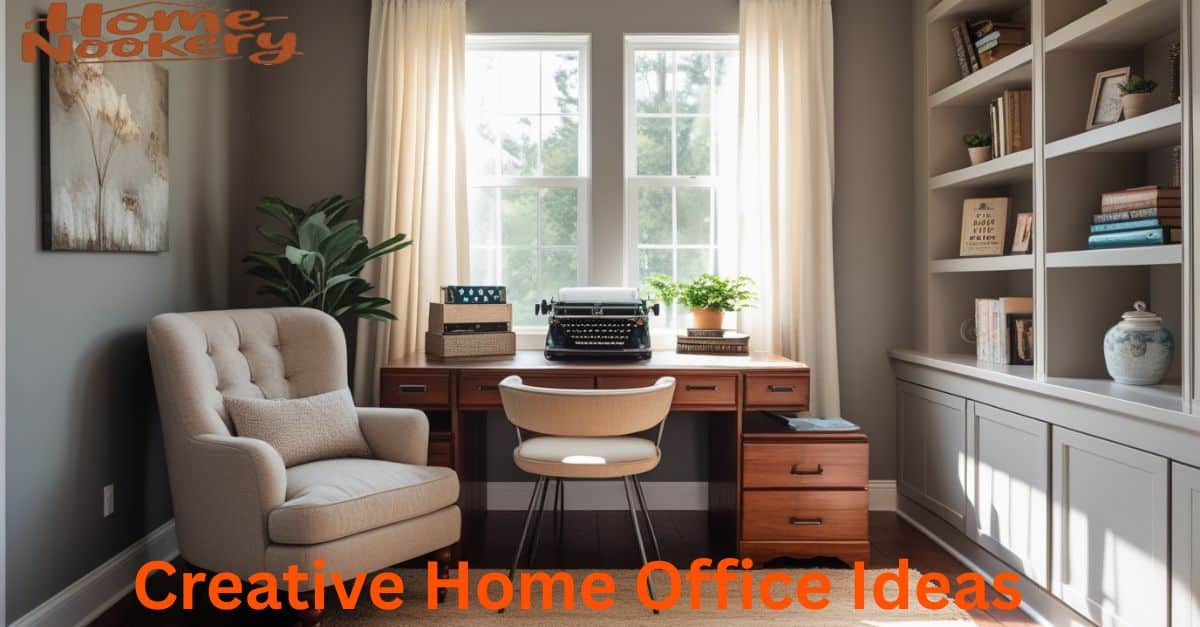Working from home ain’t what it used to be. Gone are the days when a rickety card table and folding chair in the corner of your bedroom qualified as a “home office.” As remote work has exploded in popularity, so has our collective desire to create workspaces that inspire productivity without sacrificing style. Your living room—often the heart of the home—can pull double duty as a functional workspace with just a little creativity and planning.
I’ve spent years helping clients transform awkward spaces into gorgeous work environments, and lemme tell you, the living room presents unique challenges and opportunities. It’s where we unwind, entertain, and now, increasingly, where we earn our paychecks. The trick is making it work for all these functions without feeling like you’re perpetually at the office or drowning in paperwork during movie night.
This comprehensive guide will walk you through 28 inventive ways to carve out a productive workspace in your living room that’s both practical and aesthetically pleasing. Whether you’ve got a sprawling loft or a compact apartment, there’s a solution here that’ll work for your situation.
The Corner Office Revolution
1. The Floating Corner Desk

Corners are criminaly underutilized in most living rooms. A floating corner desk takes advantage of this dead space while maintaining visual lightness. Choose a desk with slim legs or wall-mounted options to maximize floor space. The diagonal orientation creates a natural separation between work and relaxation zones without needing physical dividers.
The beauty of corner placement is the natural boundary it creates. You’re technically in the living room, but the positioning psychologically separates your work area from leisure space. Add a small area rug under your desk chair to further define the zone visually.
2. Window-Adjacent Workstation

Natural light ain’t just good for your houseplants—it’s essential for your wellbeing during work hours. Positioning your desk near a window provides not only practical lighting but also gives your eyes a needed break when you glance up from your screen. The occasional distraction of watching neighborhood happenings can be surprisingly restorative during intense work sessions.
Just be mindful of potential glare on your computer screen. A position perpendicular to the window often works best. If direct sunlight is problematic, light-filtering curtains can diffuse the brightness while still allowing that precious vitamin D to boost your mood and productivity.
3. Behind-the-Sofa Workspace

This is one of my all-time favorite solutions for smaller living rooms. A narrow console table behind your sofa creates a natural boundary while offering a decent work surface. This setup allows you to face away from the television and other distractions while working. When your workday ends, simply tuck your chair underneathe and the area transforms back into a traditional living room element.
The height of your sofa will determine whether a standard desk or counter-height surface works best. For added functionality, choose a console with drawers or cubbies to store work essentials out of sight. This arrangement creates a distinct workspace that dosent visually intrude on your living area.
Disguise and Compromise
4. The Convertible Secretary Desk

Vintage-inspired secretary desks are having a moment, and for good reason. These fold-down workstations hide everything behind a beautiful cabinet exterior when closed. Open it up, and you’ve got a compact but complete workspace with built-in organization. When the workday ends, simply close it up, and your living room returns to relaxation mode.
Modern versions come in styles ranging from mid-century to contemporary minimalist, ensuring you’ll find something that complements your existing decor. The smaller footprint makes this solution ideal for tight spaces or homes where aesthetic consistency is paramount.
5. The Murphy Desk

Similar to the famous space-saving beds, murphy desks fold up against the wall when not in use. This solution is brilliant for truly compact living rooms where every square foot matters. When folded away, some models resemble a sleek cabinet or even artwork. Many come with built-in storage that remains accessible whether the desk is deployed or not.
Installation requires some wall reinforcement, but the space-saving benefits are immense. Some creative designs even incorporate lighting elements or pinboards on the underside of the desktop, visible when the desk is closed up for the day.
6. The Nesting Workstation

A nested desk arrangement using end tables or accent pieces that can pull apart for work hours and push together when off-duty is genuinely clever. This approach provides flexibility without dedicated “office furniture” disrupting your living room aesthetic. Look for pieces with complementary heights that can serve different functions when nested versus when separated.
I recently worked with a client who used three graduated nesting tables—the largest became her laptop desk, the medium-sized one held reference materials, and the smallest served as a beverage station. When work was done, they tucked together as a stylish tiered side table beside her reading chair.
Maximizing Minimal Spaces
7. The Closet Office

If your living room has a closet you can spare, consider removing the door and transforming this nook into a dedicated workspace. Built-in shelving above a desk surface creates storage without consuming precious floor space. Add battery-powered puck lights or a small desk lamp if natural lighting is limited in this area.
The beauty of the closet office is the clear boundary between work and relaxation. When you’re done for the day, you can physically walk away from your workspace without having to pack everything up. Some of my clients have added curtains that can be drawn across the opening for complete visual separation after hours.
8. Under-Stair Utilization
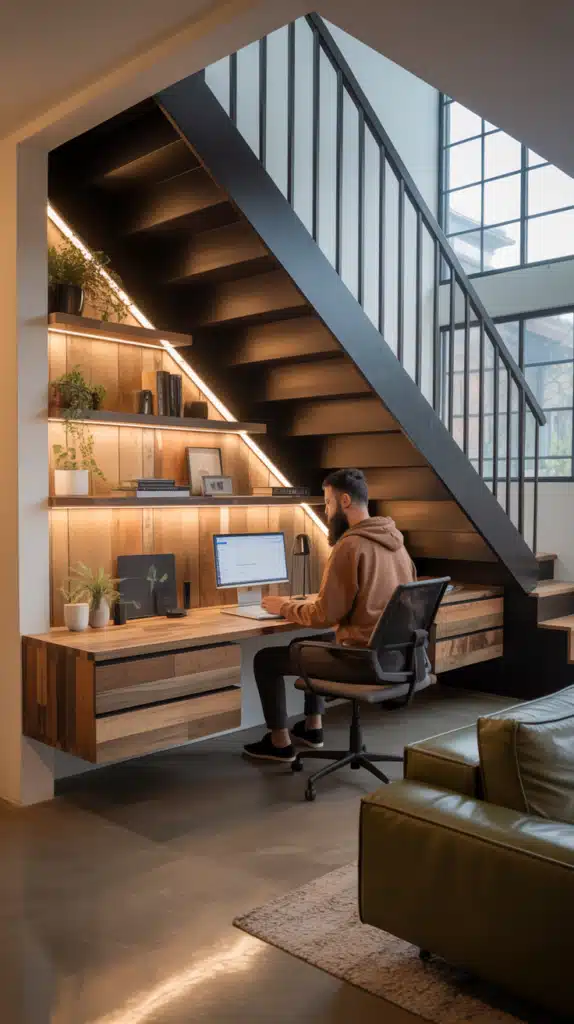
For those with split-level homes or living rooms with staircase access, the space beneath stairs represents prime real estate for a compact office. The graduated ceiling height creates natural zones for different activities—taller areas for computer work, sloped sections for shelving or pegboards. Custom built-ins maximize every odd angle and corner.
This arrangement takes advantage of square footage that’s often wasted or used for simple storage. The tucked-away nature of under-stair spaces also provides some acoustic buffering from household noise, a valuable feature in busy homes.
9. The Wall-Mounted Dropdown
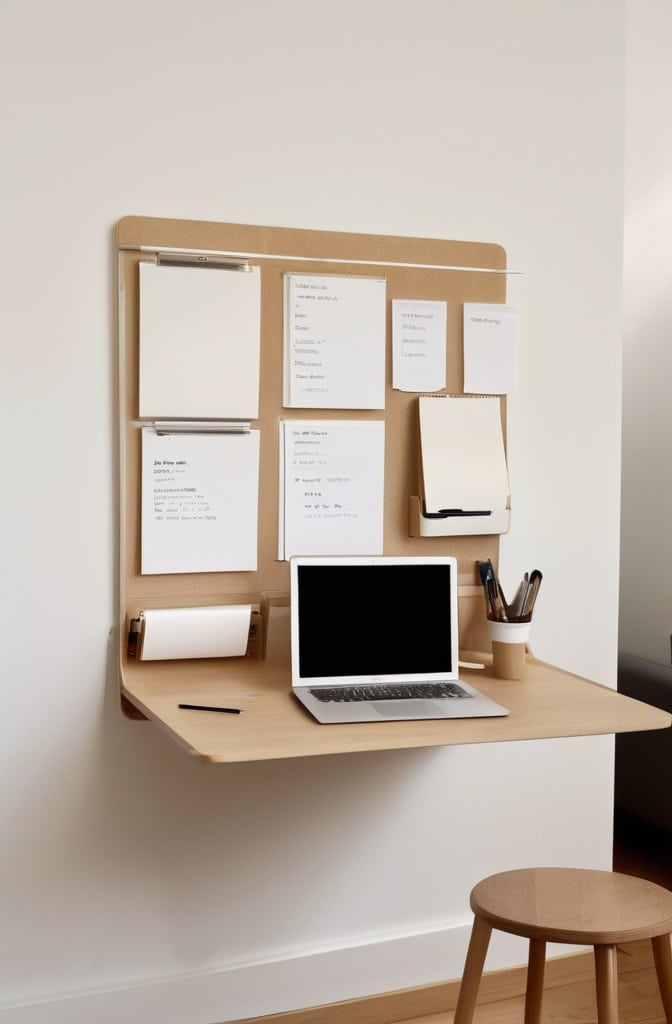
When floor space is at an absulute premium, look up! Wall-mounted folding desks occupy zero floor space when closed and provide a surprisingly functional work surface when needed. Many designs include built-in storage compartments, cable management solutions, and even integrated lighting. The compact nature forces organizational discipline—a blessing in disguise for the chronically cluttered.
These systems have come a long way from utilitarian designs of the past. Today’s options include beautiful wood finishes, sleek metals, and customizable features that make them legitimate design elements rather than mere functional compromises.
Style-Forward Solutions
10. The Statement Desk
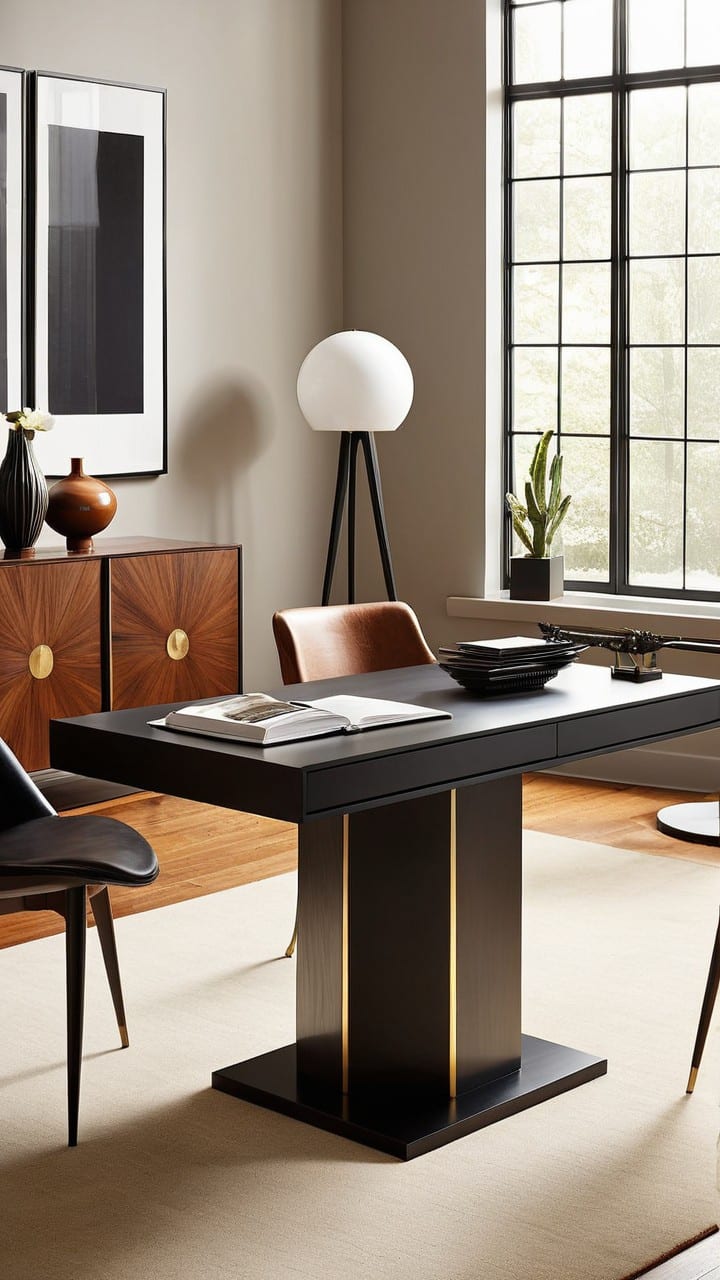
Who says your home office setup can’t be the visual centerpiece of your living room? An architecturally interesting desk—whether a restored vintage find, a modern sculptural piece, or a custom creation—can serve as a conversation starter while providing practical workspace. The key is choosing something with enough presence to hold its own among your living room furniture.
I worked with an interior designer whose living room featured a magnificent 1970s burled wood executive desk as her room’s focal point. Rather than trying to hide her workspace, she celebrated it with intentional styling and complementary living room elements. The desk became the room’s anchor rather than an intrusion.
11. Bookshelf Integration
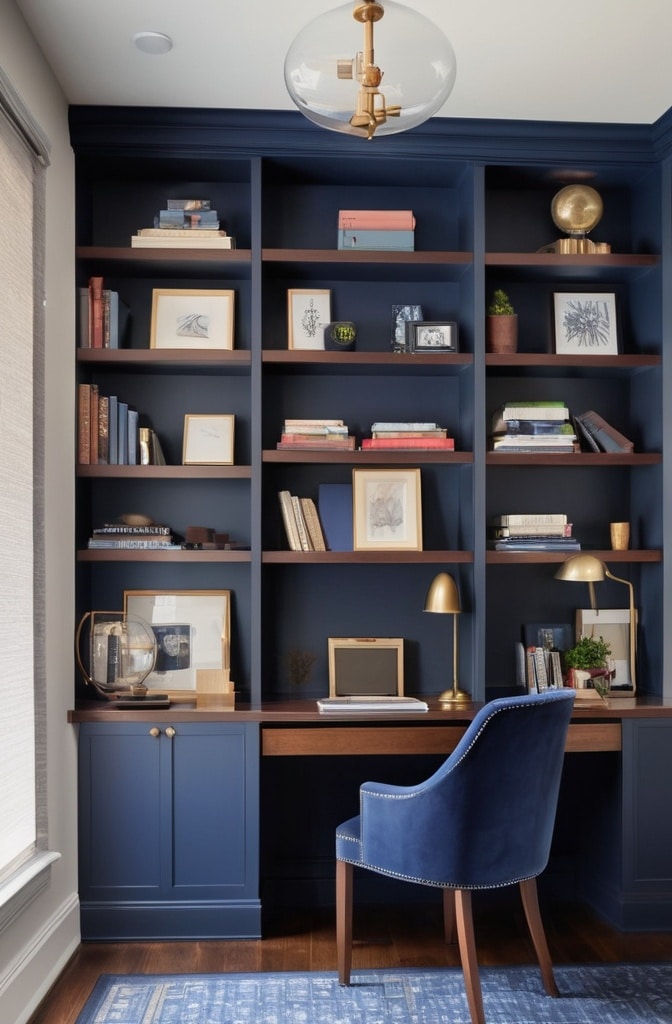
Bookcases aren’t just for books anymore. Many contemporary designs include desk sections that blend seamlessly with shelving. This approach maximizes vertical storage while creating a built-in workspace that feels like a natural extension of your living room storage. The surrounding books and decor items help your office equipment blend into the overall aesthetic.
Look for systems with adjustable components that can evolve as your needs change. Some clever designs include fold-down desk surfaces that disappear when not needed, while others feature rolling components that can extend when in use and tuck away during off-hours.
12. The Coordinated Color Story
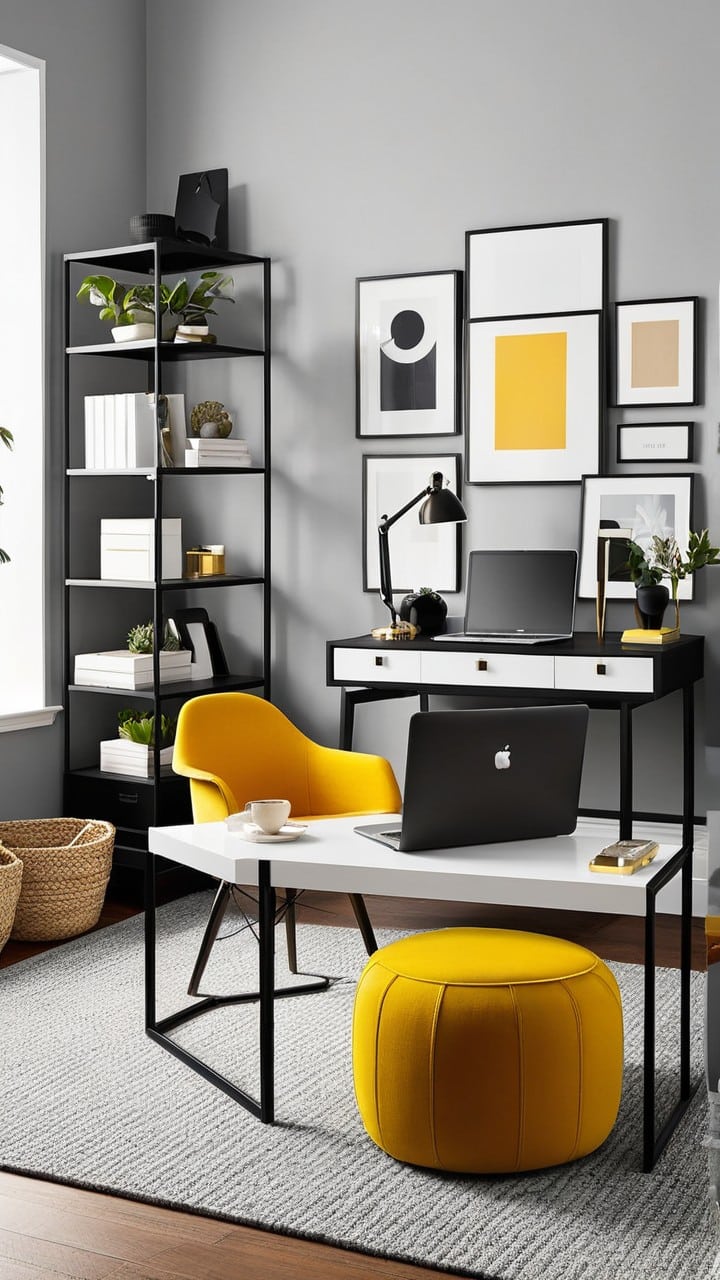
Sometimes the most effective way to integrate a workspace is through careful color coordination. By selecting desk furniture and accessories that perfectly match or intentionally contrast with your living room color palette, you create visual harmony despite the functional differences. This approach works with any style, from minimalist monochrome to maximalist color play.
I’ve seen stunning examples where a desk is painted the exact same color as living room walls, causing it to visually recede, or conversely, where a workspace is defined by a bold accent color that ties to subtle elements elsewhere in the room. Both approaches acknowledge the workspace while controlling its visual impact.
13.Feminine and Aesthetic Desk Setup
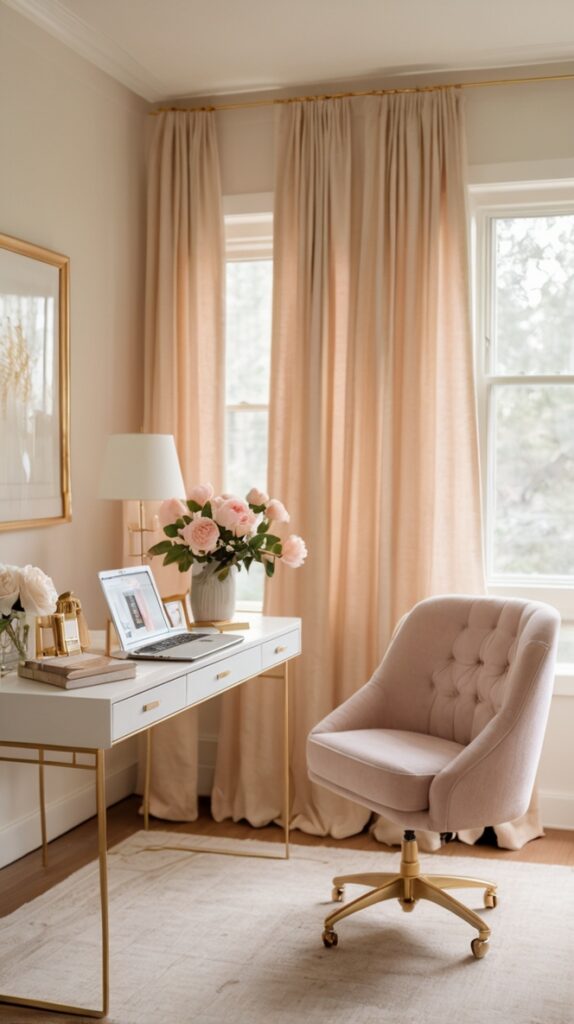
A workspace that embraces softness, elegance, and intentional design can bring calm and focus to your workday. Feminine desk setups often lean into curated details—think blush tones, gold accents, floral prints, and sculptural accessories. But the goal isn’t to gender the space—it’s to create an environment that feels personally inspiring.
Pair a delicate writing desk with a cozy upholstered chair, layer in decorative storage boxes or vases with fresh flowers, and don’t overlook lighting—a chic lamp with a warm glow can elevate both form and function. These setups work particularly well in living rooms where the workspace doubles as a personal sanctuary.
Tech-Smart Integration
14. The Cable Management Command Center
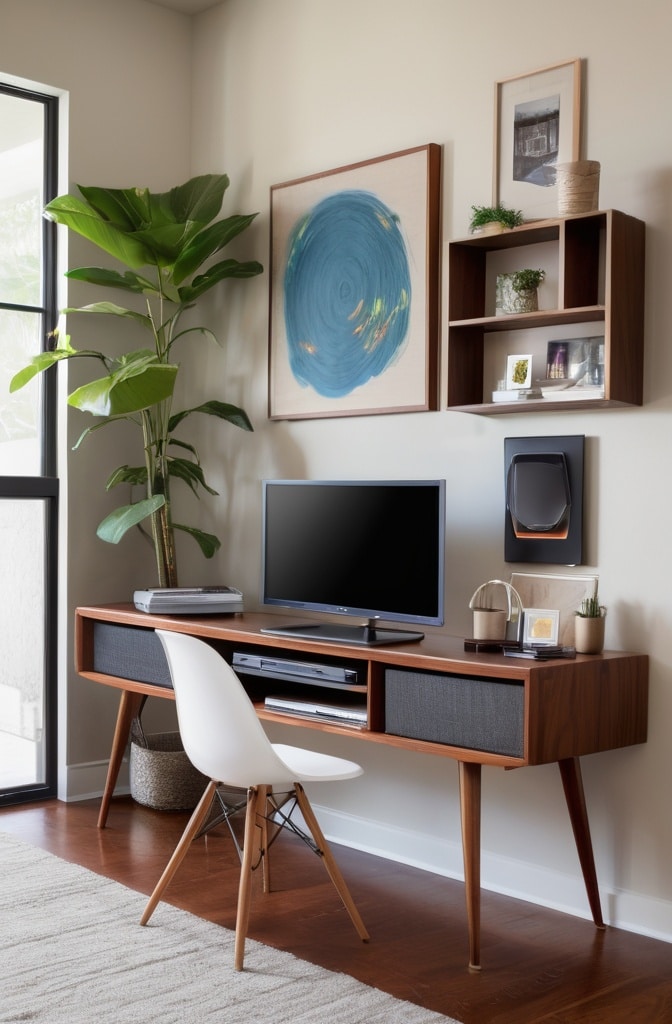
Nothing ruins the vibe of a living room faster than tangled cords and visible power strips. Investing in serious cable management solutions pays massive dividends both visually and functionally. Consider furniture with built-in channels, decorative cord covers that double as baseboards, and power solutions that integrate into existing furniture.
Products like charging end tables with built-in USB ports and AC outlets have revolutionized the home office landscape. Combined with wireless peripherals and thoughtful routing of necessary cables, these solutions maintain the refined atmosphere of a living room while providing the connectivity of a dedicated office.
15. The Digital Display Solution
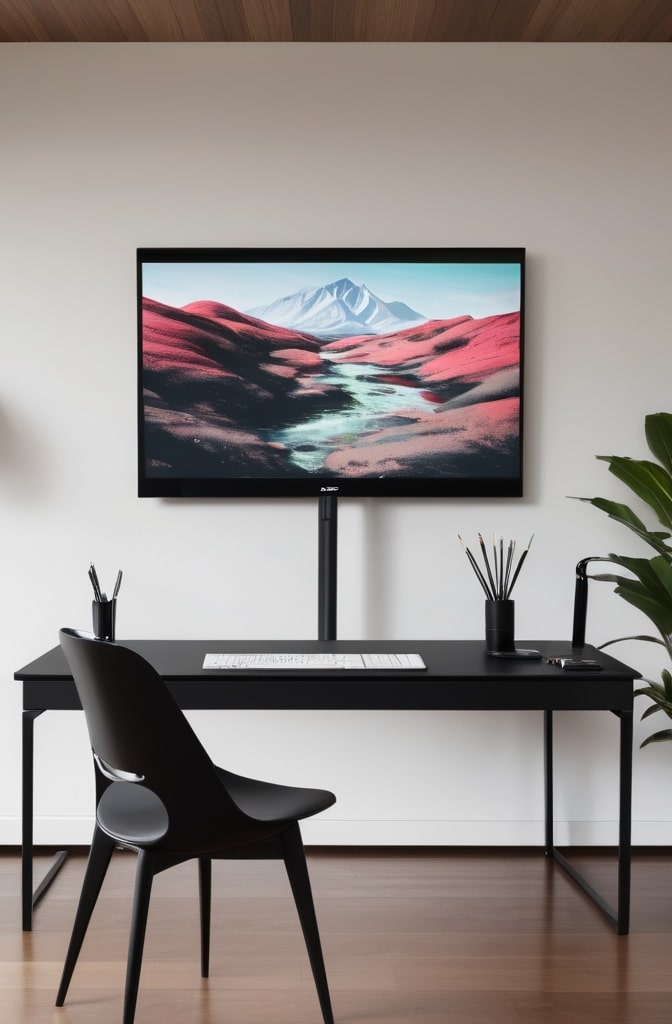
For those whose work involves multiple screens or large monitors, integrating these technical elements requires special consideration. Consider mounting screens that double as digital art displays when not in use, or selecting smart TVs that can function as both work monitors and entertainment screens. Framing your screen with decorative elements helps it blend with living room decor.
Some of the most innovative solutions involve screens that rise from consoles via remote control, monitors disguised as mirrors when powered off, or projector systems that eliminate the need for permanent screen installation altogether. The technology in this area is advancing rapidly, offering increasingly elegant solutions.
16. The Invisible Tech Approach
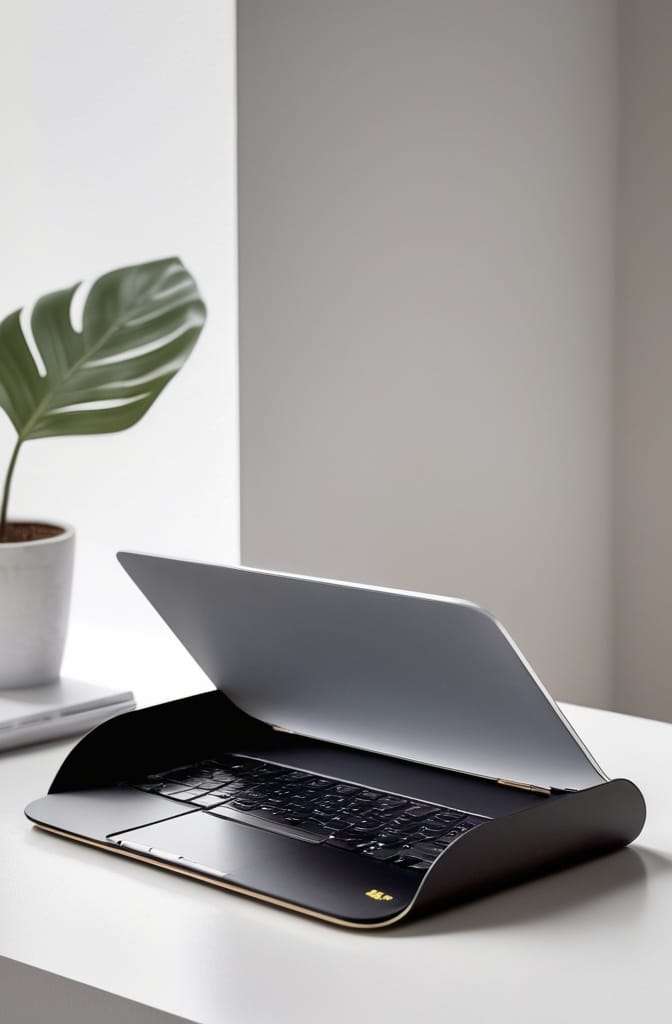
This strategy focuses on selecting the most compact and visually unobtrusive technology possible. Ultra-thin laptops, mini keyboards, wireless chargers disguised as decorative objects, and cloud-based workflows that reduce the need for peripherals all contribute to a workspace that maintains living room aesthetics. The goal is function without visual tech clutter.
Consider laptop stands that resemble sculptural objects when not holding your computer, desk accessories in materials that complement your decor (leather, wood, or metals that match existing finishes), and storage solutions specifically designed to hide technical components when not in use.
Dividing Without Walls
17. The Strategic Screen Divider
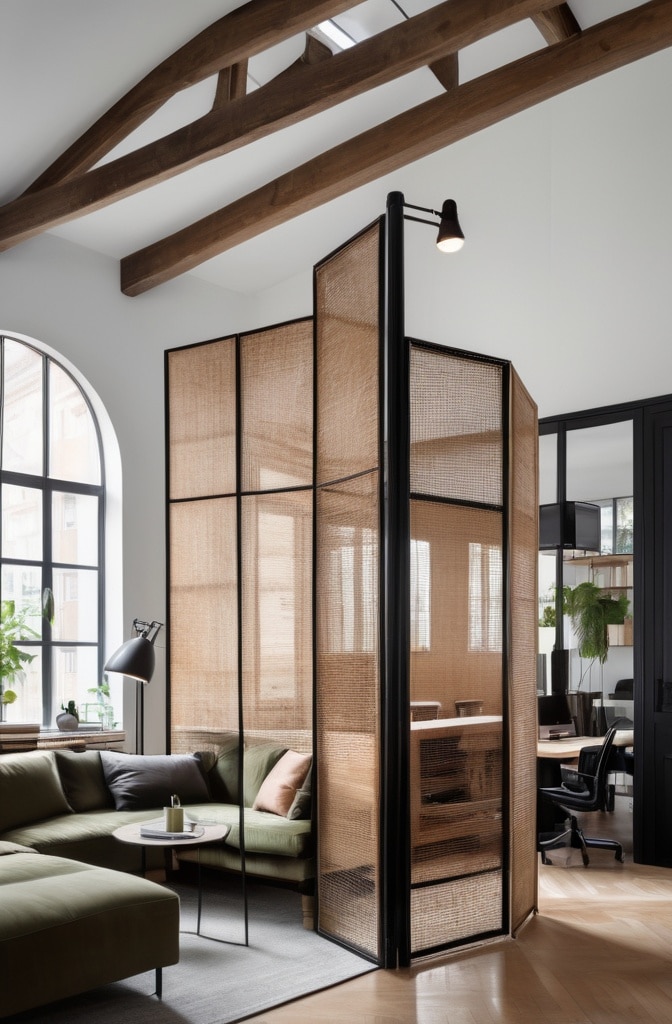
Room dividers have come a long way from clunky folding panels. Today’s options include beautiful architectural screens, open shelving units that provide partial visual separation while allowing light flow, and even hanging panel systems that can be reconfigured as needed. These elements create psychological boundaries without permanent construction.
The most successful dividers serve multiple functions—perhaps incorporating storage, displaying decorative objects, supporting plants, or even housing lighting elements. The goal is division that enhances rather than compartmentalizes your living space.
18. The Curtain Call
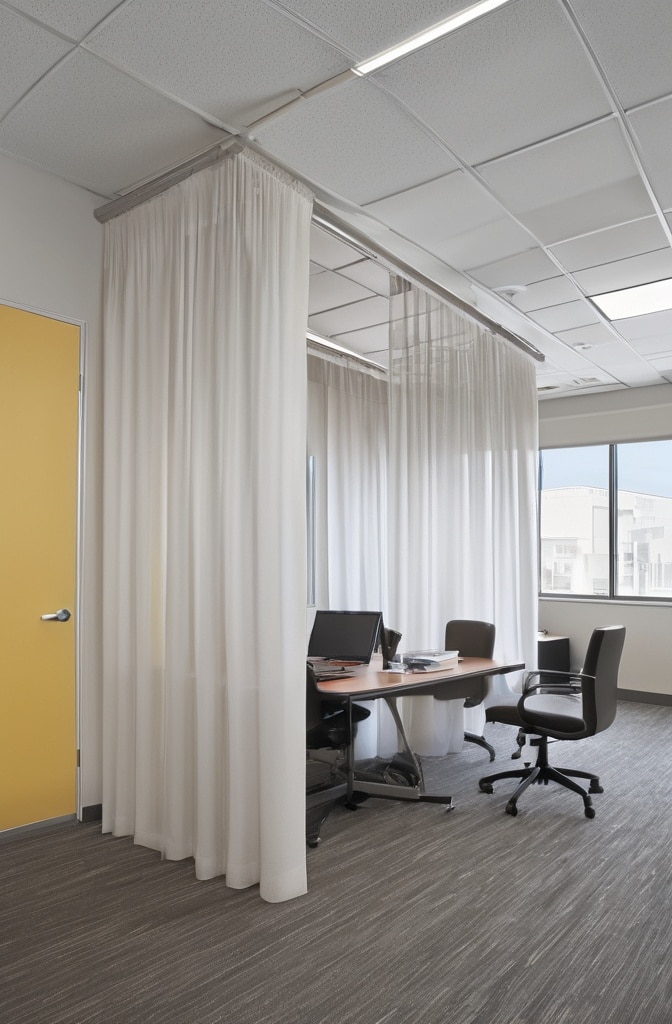
For an incredibly flexible solution, consider ceiling-mounted curtain tracks that allow you to “close” your office when not in use. Options range from sheer fabrics that filter light while providing visual softness to heavier textiles that offer more substantial separation and noise reduction. This approach requires minimal permanent installation while offering maximum adaptability.
The textile you choose dramatically impacts both functionality and aesthetics. A heavy velvet creates drama and significant separation, while linen or cotton provides lighter definition. Some homeowners even use outdoor fabrics for their stain resistance and durability—particularly important if your workspace doubles as a creative studio.
19. Furniture as Dividers
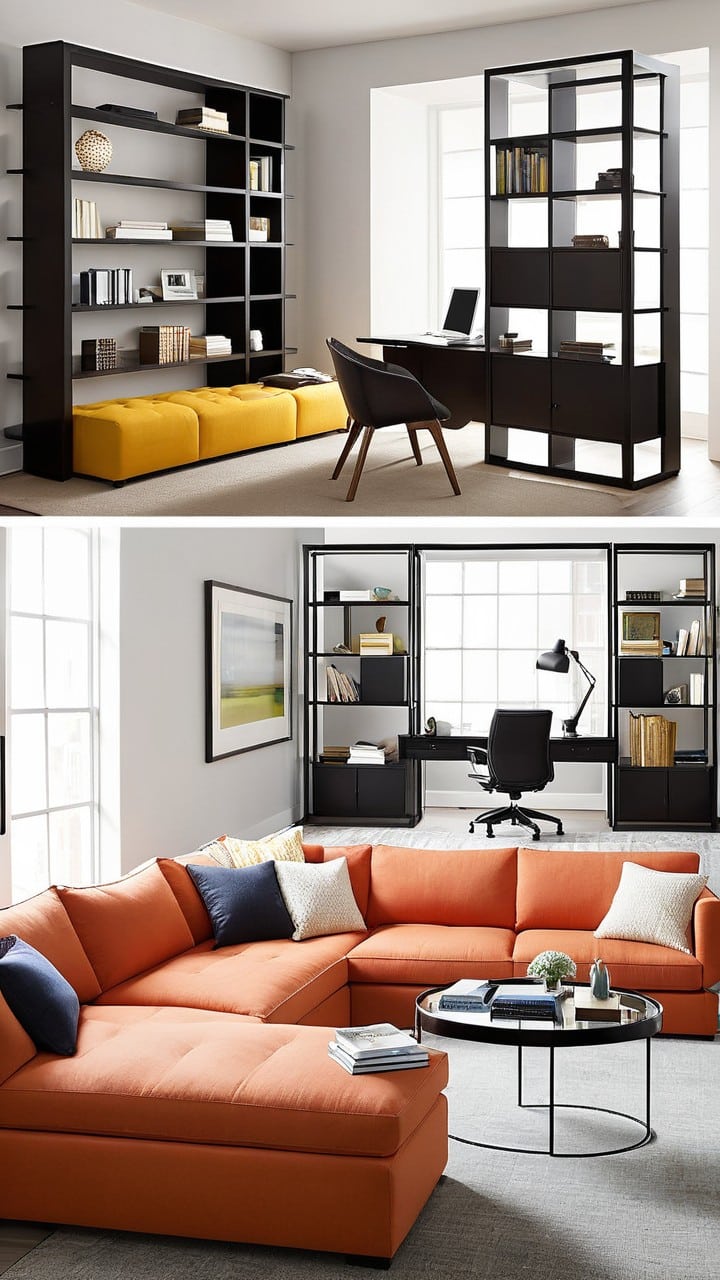
Strategic furniture placement can define a workspace without dedicated dividing elements. Consider floating your sofa in the room with your desk behind it, using a bookcase perpendicular to a wall to create a nook, or employing a console table with decorative objects as a visual boundary. These approaches maintain openness while establishing distinct zones.
The height of dividing furniture significantly impacts the feel of separation. Lower pieces maintain visual connection across the space, while taller elements create more definitive boundaries. Your choice should reflect both practical needs (like noise reduction) and aesthetic goals for the overall room.
Comfort Meets Function
20. The Double-Duty Seating

Your office chair doesn’t need to look like it belongs in a corporate cubicle. Consider comfortable options that work visually in both work and leisure contexts—a handsome leather armchair on casters, a plush upholstered chair that complements your sofa, or even an ergonomic chair customized with fabric that coordinates with your living room textiles.
Some innovative manufacturers now offer residential/commercial hybrid seating that provides proper support for workdays but looks appropriate in home settings. Alternatively, slipcovers designed specifically for office chairs can transform utilitarian pieces into design elements that blend with your living room aesthetic.
21. The Ergonomic Evolution
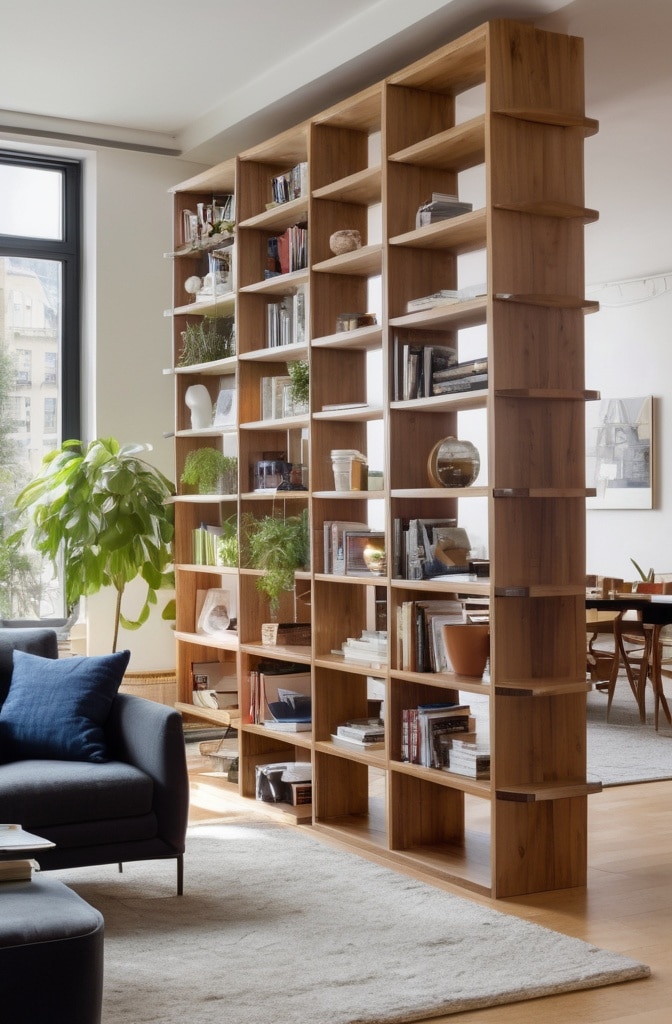
Proper ergonomics remain essential even in living room workspaces. Consider adjustable-height surfaces that allow for both sitting and standing, monitor arms that ensure proper screen placement, and keyboard trays that promote healthy wrist positioning. Many of these elements can be integrated discretely or selected in designs that complement residential aesthetics.
Even small ergonomic additions make tremendous differences in comfort—a footrest that resembles an ottoman, a lumbar pillow that matches your decorative cushions, or a desktop organizer that keeps frequently used items within proper reaching distance. Prioritize these elements for long-term wellbeing.
222. The Sensory Consideration
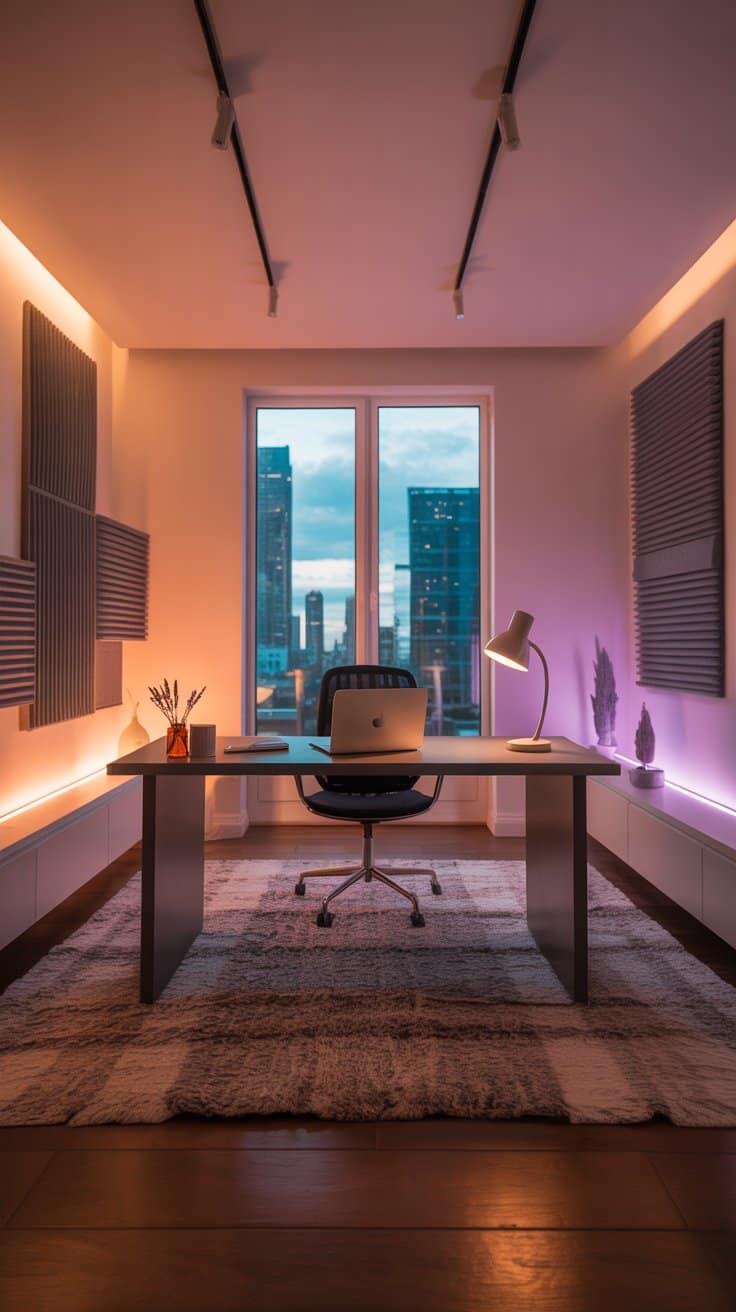
A successful living room office addresses all senses. Consider acoustic panels disguised as artwork to absorb sound, essential oil diffusers or candles in scents proven to enhance concentration, adjustable lighting that supports different work tasks while contributing to the room’s ambiance, and textural elements that provide tactile comfort during long work sessions.
These subtle adjustments significantly impact both productivity while working and relaxation when the workday ends. The multi-functional nature of living rooms demands this sensory flexibility to support the space’s shifting purposes throughout the day.
Storage and Organization
23. The Vertical Victory
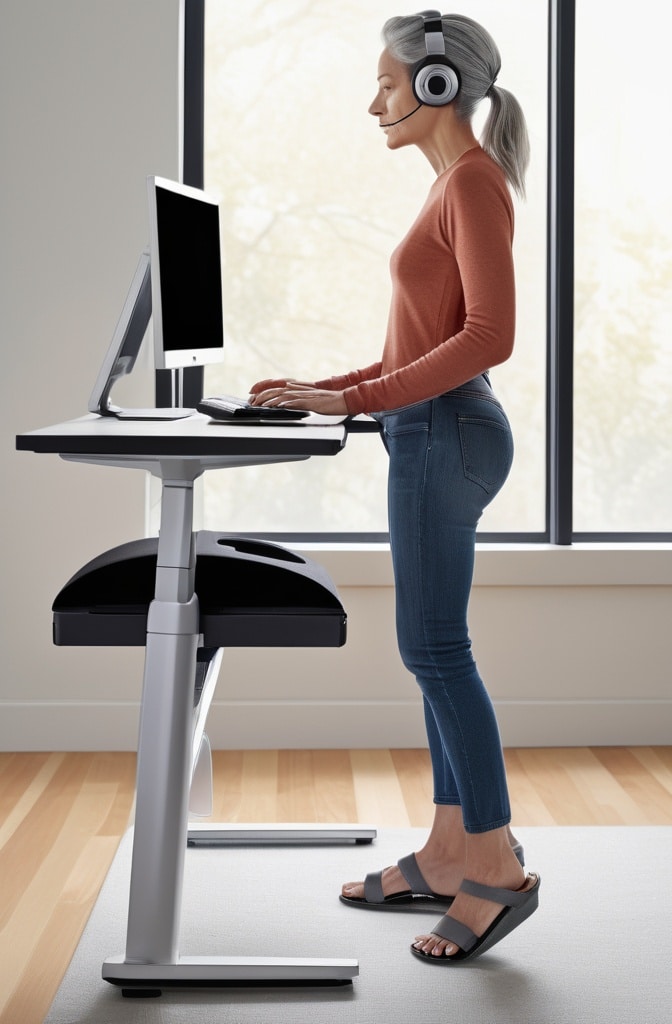
When floor space is limited, vertical storage becomes your greatest ally. Wall-mounted organizers, floating shelves installed above your desk area, and tall, narrow cabinets maximize storage capacity with minimal footprint. These elements can become decorative features through careful selection of materials and thoughtful styling.
The most successful vertical storage solutions in living rooms incorporate both closed and open components—cabinets or boxes to hide utilitarian office supplies and visually appealing open shelving to display books, plants, or decorative objects that complement your living room decor.
24. The Hidden Compartments

Furniture with secret storage compartments offers the ultimate solution for living room/office hybrids. Consider ottomans with removable tops that reveal file storage inside, coffee tables with lift-tops that become work surfaces while exposing storage beneath, or side tables with deceptively spacious drawers specifically dimensioned for office supplies.
These pieces provide convenience without sacrificing style, allowing you to keep essential items close at hand but completely concealed when not needed. The psychological benefit of being able to literally close the lid on work items at day’s end shouldn’t be underestimated.
25. The Basket Brigade

Never underestimate the power of attractive containers to transform organizational needs into design elements. A collection of coordinating baskets, boxes, or bins can corral office essentials while contributing to your living room’s aesthetic appeal. Labels can be as minimal or decorative as your style dictates, and containers can be quickly relocated when transitioning the space.
I’m particularly fond of solutions like magazine files covered in decorative paper that match your color scheme, vintage metal cash boxes repurposed for supplies, or handwoven baskets that add textural interest while hiding less attractive necessities. These elements acknowledge the room’s dual purpose while maintaining design integrity.
Finishing Touches
26. The Plant Partnership
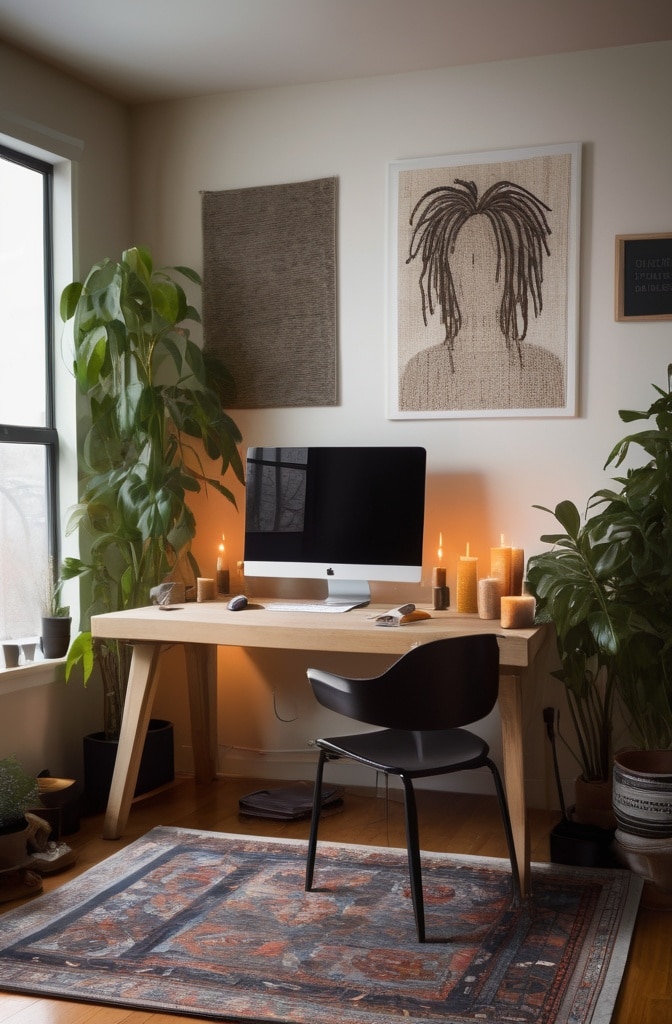
Biophilic elements are crucial in work environments, and living room offices are no exception. Strategic placement of plants can not only enhance aesthetics but also create natural boundaries, improve air quality, and boost mood. Consider a large floor plant beside your desk area, trailing varieties on shelving above your workspace, or a collection of small specimens on your work surface.
The varieties you choose should balance beauty with practicality—some plants thrive in lower light conditions typical of indoor spaces, while others require minimal maintenance for busy professionals. The containers themselves become important design elements that tie your workspace to the broader living room scheme.
27. The Art of Inspiration
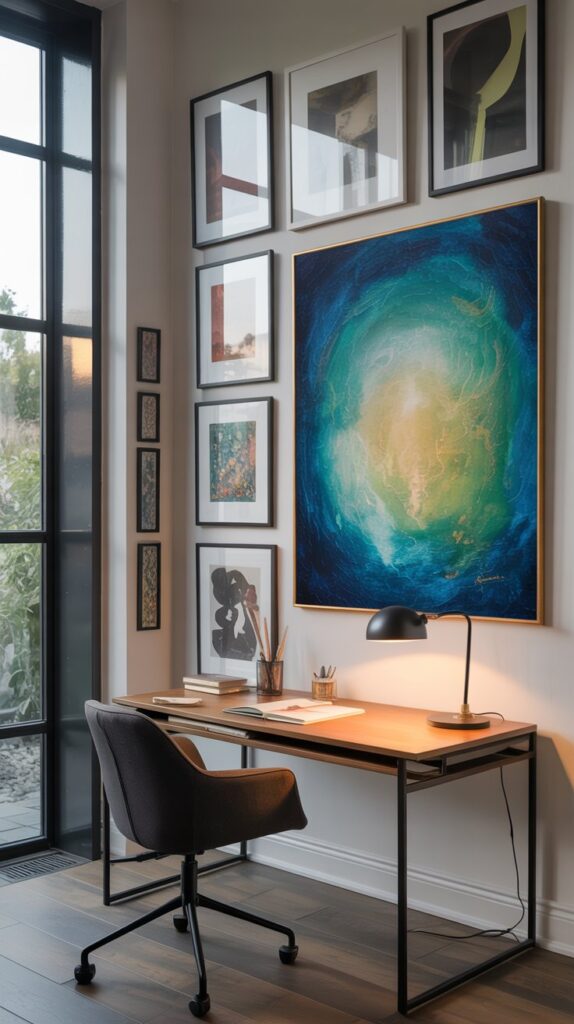
Thoughtfully chosen artwork transforms a utilitarian workspace into an inspiring environment. Consider a small gallery wall above your desk, a single statement piece that establishes your color palette, or a rotating display that allows you to refresh your visual inspiration regularly. Art bridges the functional aspects of your workspace with the living room’s role as a reflection of personal style.
Unlike corporate environments with strict decorating guidelines, your living room office can feature deeply personal artistic choices that motivate and energize you. The psychological benefits of surrounding yourself with imagery that resonates emotionally shouldn’t be underestimated when establishing a productive workspace.
28. Hidden Desk in a Wardrobe or Closet
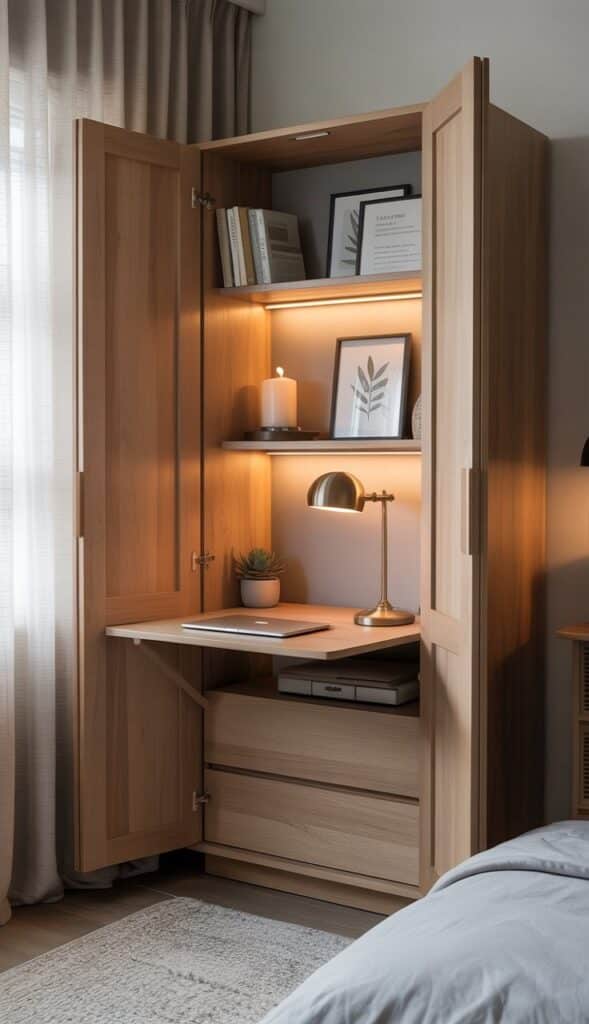
For those craving total concealment, transforming a wardrobe or armoire into a hidden desk setup is genius. When the doors are closed, it’s just another piece of furniture. But open it up, and you reveal a complete micro-office with shelves, lighting, and a compact work surface.
This solution is ideal for multipurpose rooms or homes where visual clutter needs to be kept at bay. Use cable grommets for neat cord management, install puck lighting or LED strips inside, and personalize with small decor items that reflect your style. At day’s end, close the doors and the office disappears.
Bringing It All Together
Creating a living room with a home office isn’t about one-size-fits-all solutions—it’s about tailoring the space to your needs, limitations, and style. The best designs embrace the room’s dual function instead of hiding it.
The work-from-home shift has redefined how we use our homes. Rather than viewing this change as temporary, integrating workspaces into living areas reflects modern life. With creativity and purpose, your living room office can be both functional and beautiful.
These 27 ideas are just a starting point. Mix, match, and adapt them to craft a space that boosts productivity, fits your aesthetic, and enhances daily living. The right balance is out there—it’s all about finding what works for you.

Mariana is the founder and voice behind Home Nookery, a curated blog dedicated to home design, décor inspiration, and cozy living. With a passion for creating beautiful, functional spaces, Mariana shares practical tips, styling ideas, and thoughtful insights to help readers turn their houses into homes. Whether you’re redesigning a room or just adding a touch of charm, she’s here to guide you with creativity and heart.
